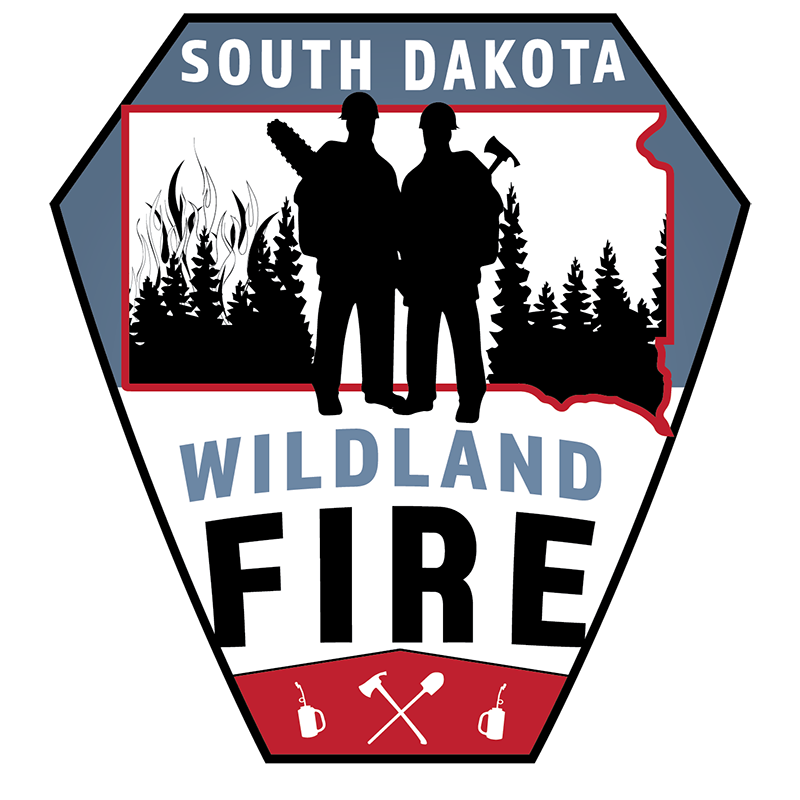
Fuels Mitigation
Hazardous Fuels Mitigation Cost-Share Program
Our program is intended to create or enhance survivable space around homes and provide a setting within the Wildland Urban Interface (WUI) where, in the event of a fire, the intensity and rate of fire spread can be reduced.
Treatment will promote forest health by mimicking the effects that fire would have on the landscape by removing unhealthy trees and creating improved conditions for remaining trees, shrubs, and forbs.
This program provides 80% cost-share funds to reduce the threat of extreme fire by removing hazardous fuels through thinning and ladder fuel removal. Treatments areas will meet or exceed international wildland fire safety standards.
Mitigation will target and remove deformed, diseased, storm damaged, broken topped coniferous (pine, cedar, spruce) trees while encouraging deciduous vegetation growth. Remaining conifers will be removed until a spacing of 25 feet between trees is achieved and remaining trees will be limbed 6-8', not to exceed 1/3 of the total tree height, to eliminate ladder fuels. This will result in a variety of stronger trees and will reduce competition for nourishment which will create a healthier forest.
Projects that may be cost-shared are:
- Thinning dense stands of trees
- Firebreaks and fuel-breaks
- Thinning of forest stands and removal of volatile fuels
This program is not intended for:
- Removal of select trees due to various forms of tree mortality (i.e. disease/bug tree removal).
- Removal of slash piles or chip piles, and cut & chunk materials that have been left as a result of previous treatments, unless they pose an immediate threat to the home.
- Large-scale (over 10 acres) fuels reduction treatments.
- Any treatment that does not meet the objectives of this program for creating survivable space.
If you are interest in cost share, a free property assessment, or information about Firewise, please contact:
Brittany Seidl
Fuels Coordinator
Rapid City office
605-394-2638
brittany.seidl@state.sd.us
Adam Fritz
Assistant Fire Management Officer - Fuels
Rapid City office
605-394-5203
adam.fritz@state.sd.us
Lane Ostenson
Assistant Fire Management Officer - Fuels
Custer office
605-252-5701
lane.ostenson@state.sd.us
Jordon Harrington
Assistant Fire Management Officer - Fuels
Lead office
605-252-5648
jordon.harrington@state.sd.us
Logan Brown
Fuels Program Manager
Rapid City office
605-394-2584
logan.brown@state.sd.us
Wildland Urban Interface (WUI)
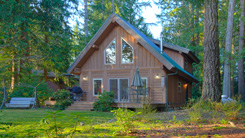
Most WUI fires we will experience within the Black Hills will not be weeklong events; most will not be multi-day events - most will be over in a matter of a few hours. By the time distant resources arrive to fight the fire, most of the activity will already be over. This is why it is imperative you do your part now, before the fire arrives.
WUI is the set of conditions found where natural areas and human development meet. By this definition, the WUI is not a specifically defined area but encompasses all areas where the conditions are right. WUI conditions can be found in rural areas or in the middle of town - it all depends on the surrounding environment.
The WUI has increased in importance as more and more people build homes in previously undeveloped areas. Mitigation and moving are the only two ways to assure safety in the WUI. South Dakota Wildland Fire can assist with information and funding for mitigation activities.
Our office works with communities to reduce future wildfire risks to homes, increase public and firefighter safety, reduce risk of unwanted fire and increase public understanding of fire management.
Hazardous fuel mitigation will reduce future wildfire risks to homes and increase public and firefighter safety. There is no way to eliminate fire from the landscape, but with some work, we can have some control over where it burns and how severe it burns.
We have many resources available to assist in hardening your home and property against fire to increase the chance it has of surviving a fire without fire department intervention.
Learn about becoming Firewise around your home through the Home Ignition Zone concept.
Please review our seasonal homeowner information tab to learn some of the simple and cheap things you can do around your home to help it withstand a wild fire or ember shower.
We can also assist with tree removal or thinning projects through our Hazardous Fuels Mitigation Cost-Share Program.
Seasonal Homeowner Information
By doing a few basic home maintenance items now, before smoke is in the air, can significantly increase the chances your home has to survive a wildfire without fire department intervention.
Do not wait until the middle of fire season to take action. Creating and maintaining a Firewise home should be a year-round process.
Spring - Now is the time to clean up your property by:
- Clearing dead grasses from around your property and home
- Raking debris to a safe location
- Clearing gutters and roofs
- Moving firewood at least 30 feet from all structures
- Hardening your home by closing spaces under decks and installing screening on vents
- DO NOT burn existing piles. The dead, dry fuels will quickly spread fire and can turn the smallest spark into a destructive wildfire. Leave the burning for winter.
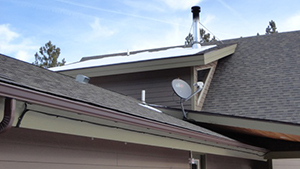
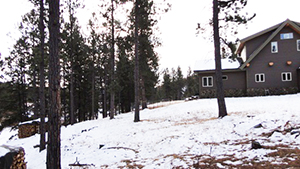
Summer - Utilize these months to focus on home maintenance and Firewise landscaping:
- Create a fire-resistant landscape by choosing appropriate plants
- Maintain your grass by keeping it mowed no higher than 4 inches for at least 30 feet around your home
- Maintain your home in a fire-resistive state by performing basic home maintenance when required
- Continually clean your roof and gutters
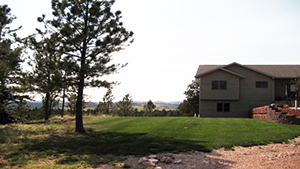
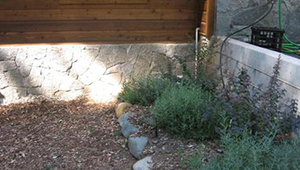
Fall- Now is the time to prepare your land and trees:
- Limb trees to at least 10 feet from the ground and away from structures
- Trees within 30 feet of your home should have at least 30 feet of separation between them to prevent fire spread
- Remove any dead/downed material that is lying on your forest floor
- Remove or prune bushes and shrubs as they create a ladder for fire to climb from the forest floor up to the tree canopy, which can quickly become uncontrollable
- When building slash piles:
-- Do not place them under the drip lines of trees where the pile could ignite the tree
-- A pile six feet wide by six feet tall is a good size for limbs and branches; the piles will shrink down when the branches dry out and needles fall off
-- Build piles at least 30 feet away from any structures
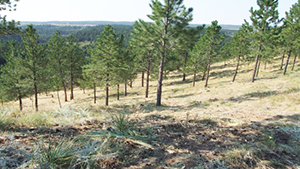
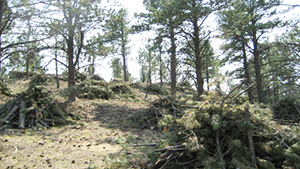
Winter
The chance of wildfire is usually reduced, but winter is a great time to prepare for the warm, dry months coming soon:
- Burn slash piles in the winter months when weather conditions are appropriate
- Obtain a burn permit BEFORE doing any burning and follow all burning regulations
Winter is also a good time to participate in local wildfire planning meetings or begin planning for your neighborhood to become a Firewise Community.
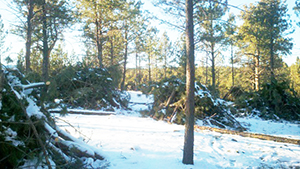
Are you prepared for a wildfire?
Now is the time to take action, not when smoke is in the air.
Ember Safety
Various stages of assault occur as a building is exposed to a wildland fire.
1. Ashes are cast in front of a fire out of a smoke or convection column, which can result in secondary ignitions.
2. Heavier embers that have more weight and may contain more heat, to serve as sources of ignition, arrive second.
3. Finally, the actual intrusion of a flame front and the radiant heat flux can expose combustibles stored outside of a building and the exterior structure of a building to various levels of radiant heat.
A study has revealed the actual exposure of a building to the flame front of wildland fires is usually less than six minutes. However, the exposure time to other materials, such as embers, that can result in proliferation of ignitions can be much longer.
To enhance structural survivability, the self-defense mechanisms must, first, do everything possible to prevent the ignition of materials around your home from embers that are cast ahead of the fire and, second, they must withstand the assault of the flame front on the structure to prevent flames from penetrating into the interior of your home.
Many communities have homes that are not necessarily at direct risk from the main fire front. However, due to the close proximity of homes to one another and surrounding vegetation (cedars, junipers) or flammable building materials involved (cedar shake roofing and wooden siding), the community is at greater risk of structure ignition from embers. Once one or two homes have ignited, structure to structure ignition then becomes an imminent threat. Whole communities have been lost in wildland fires across the US in this manner. Many were not in the direct path of the main fire.
Statistically, embers are what burn down homes, not big flames. If you can harden your home from an ember storm, you can greatly increase the odds your home will survive without fire department intervention.
State Crew Mitigation
This program is designed to establish fuel breaks in critical areas as well as perform large-scale fuel treatments. Treatments areas will meet or exceed international wildland fire safety standards.
South Dakota Wildland Fire uses our two 20-person Handcrews - the Black Hats and Bear Mountain. These crews perform fuels reduction work around the Black Hills when not on fire assignments. Project locations are chosen with input from State, Forest Service, city/county agencies, and local fire departments. Homeowners located in these areas may receive up to 100% cost-share. If your home is within a proposed project area, you will receive a letter in the mail containing project information.
For further information, contact:
Adam Fritz
Assistant Fire Management Officer - Fuels
605-394-5203
Firewise Information
The Role of Fire
Fire is a natural process on the landscape. Fire has helped shape our wild lands for thousands of years and is important for the survival of many plants and animals. Fire reduces accumulation of vegetation that can inhibit plant growth. Periodic fire stimulates growth, increases reproduction of plants, and regenerates wildlife habitat.
Survivable Space Around Your Home
Survivable space is an area around your home in which the fuels such as trees, grass, and brush have been modified or eliminated to reduce the intensity of a wildfire or stop the spread all together.
Mitigation plans have historically been utilized to create defensible properties, when they actually are intended to create survivable properties. Survivable space aims to enable properties to better withstand a wildfire without intervention and direct protection provided by firefighting forces. During a significant wildfire event, it is likely that there may not be adequate firefighting resources available or conditions will not allow for protection of all homes.
The Home Ignition Zone
The home ignition zone, the area around your home which determines the survivability of your home in the event of a wildland fire, is divided into three zones based on distance from the home.
This is a list contains suggestions and recommendations and is intended to serve as a guide to increase the chances of your home surviving a wildland fire without fire department intervention.
Immediate Zone 1: 0-5 feet from your home
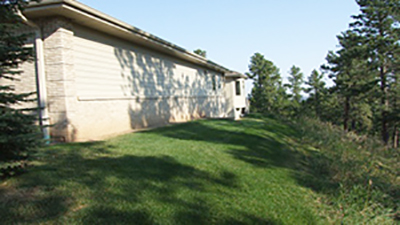
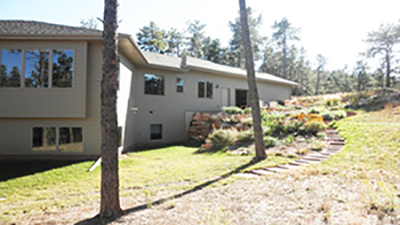
Your Home:
- Noncombustible roofing and siding
- Noncombustible soffits and overhangs
- Remove debris from roofs and gutters
- Double pane windows
- Screen all windows and vents with 1/8 inch or smaller metal screening
- Enclose chimneys with an approved spark arrester
- Relocate flammable items such as patio furniture, brooms, flowerboxes, and doormats inside or away from your home during months of high fire probability
Immediate Landscape:
- Few trees and shrubs should be located within this zone
- Fire resistive plants without volatile oils and resins (no juniper/cedar)
- Maintained and well-watered grass mowed to less than 4 inches
- Tree crown spacing at least 30 feet apart
- Keep tree crowns at least 10 feet from your home
- Rock mulch buffer around home with wood mulch at least 12 inches away
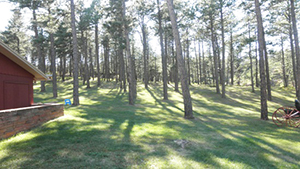
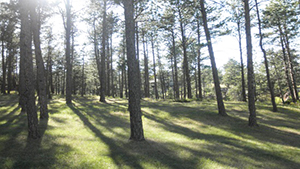
- Sparse juniper and other coniferous shrubs
- Average tree crown spacing of 30 feet
- Keep tree crowns at least 10 feet from your home
- Encourage deciduous tree growth
- Keep firewood and propane tanks at least 30 feet from your home and maintain a clear area around them. Consider burying your propane tank.
- Use driveways, retaining walls, sidewalks, and patios as fuel breaks
Extended Zone 3: 30-100 feet from the home
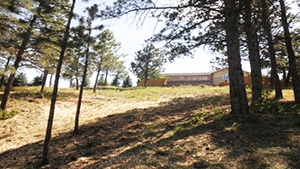
- Remove all:
-- Storm damaged trees
-- Multiple crown trees (groups of trees too close together)
-- Trees deemed otherwise unhealthy (insect or disease)
- Average pine crown spacing should be 30 feet
-- Average spruce group spacing should be 30 feet apart, left in groups of 5-10 trees




